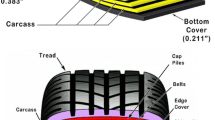Abstract
The normalized heat load approach is used to analyze the severity of warehouse fires involving a large volume of rubber tires. The results suggest that for a compartment with a fire resistance rating of two hours, the maximum number of tires that can be stored safely per square meter of compartment surface area is 0.8 to 1.2 for normal weight concrete walls, and 0.4 to 0.7 for lightweight concrete walls.
Similar content being viewed by others
Abbreviations
- A :
-
total surface area of compartment boundaries, m2
- c :
-
constant pressure specific heat of boundary walls, J/(kg · K)
- c g :
-
constant pressure specific heat of fire gases, J/(kg · K)
- g :
-
gravitational acceleration, 9.8 m/s2
- G :
-
total wood equivalent fire load, kg
- h :
-
outside free convection heat transfer coefficient, W/(m2 · K)
- h v :
-
height of ventilation opening, m
- H :
-
normalized heat load, s1/2 K
- k :
-
thermal conductivity of boundary walls, W/(m · K)
- \(\sqrt {k\rho c}\) :
-
thermal inertia of boundary walls, J · m−2 s−1/2 K−1
- mig :
-
mass flow rate of fire gases, kg/s
- N :
-
total number of tires
- q :
-
thermal assault on the boundaries, W/m2
- Q :
-
heat rate, W
- R :
-
wood equivalent burning rate, kg/s
- t :
-
time, s
- T :
-
temperature, K
- δ :
-
boundary wall thickness, m
- ρ :
-
density of boundary walls, kg/m3
- ρ a :
-
density of outside air, kg/m3
- б :
-
Stefan-Boltzmann constant, 5.67 × 10−8 W/(m2K4)
- τ :
-
fire resistance rating, hrs
- τ * :
-
fire duration, s
- Φ :
-
ventilation parameter, kg/s
- a :
-
outside air
- c :
-
combustion
- g :
-
fire gases
- o :
-
outside surface of boundary walls
- r :
-
radiation
- v :
-
ventilation opening, or convection
- w :
-
boundary walls
References
“National Fire Code of Canada, 1985,” issued by the Associate Committee on the National Fire Code, National Research Council of Canada, Ottawa, Canada, p. 38.
“National Fire Code of Canada, 1990,” issued by the Associate Committee on the National Fire Code, National Research Council of Canada, Ottawa, Canada, p. 36.
CAN4-S101-M82, “Standard Methods of Fire Endurance Tests of Building Construction and Materials,” Underwriters' Laboratories of Canada (1983).
Harmathy, T. Z. and Mehaffey, J. R., “Post-Flashover Compartment Fires,”Fire and Materials,7,2, pp. 49–61 (1983).
Harmathy, T. Z., “Effect of the Nature of Fuel on the Characteristics of Fully Developed Compartment Fires,”Fire and Materials,3,1, pp. 49–60 (1979).
Cotton, P. E. and Newman, R. M., “Fire Tests of Palletized and Racked Tire Storage,” Factory Mutual Research Corporation Report No. 19037, Norwood, MA (July 31, 1970).
“Tire Storage,” Factory Mutual System, Loss Prevention Data Sheet 8-3, Norwood, MA (August 1977).
Harmathy, T. Z., “A New Look at Compartment Fires, Part I,”Fire Technology,8,3, pp. 196–217 (1972).
“Supplement to the National Building Code of Canada, 1985,” issued by the Associate Committee on the National Building Code, National Research Council of Canada, Ottawa, Canada, p. 32.
Holman, J. P., “Heat Transfer,” 5th edition, McGraw Hill, New York, p. 276 (1981).
Harmathy, T. Z., “A New Look at Compartment Fires, Part II,”Fire Technology,8,4, pp. 326–351 (1972).
Author information
Authors and Affiliations
Rights and permissions
About this article
Cite this article
Yung, D., Mehaffey, J.R. Fire resistance requirements for rubber-tire warehouses. Fire Technol 27, 100–112 (1991). https://doi.org/10.1007/BF01470862
Issue Date:
DOI: https://doi.org/10.1007/BF01470862




